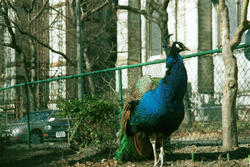his peacock lives on the grounds of
the
Cathedral of St. John the Divine. There are (or were) two of them,
but as you can see here, it is difficult to persuade them to spread
their celebrated tail feathers. Anyone speak Persian?


Someone wrote:
"Car horns blared and ambulance sirens shrilled, but the two peacocks parading through the gardens at the Cathedral Church of St. John the Divine were unfazed as they continued to peck and preen.
"It's a beauty seeing them over there," said Linda Burnett, a home health aide, who comes to the cathedral to sit and relax during lunch. "They are beautiful birds and they are friendly."
Peacocks, whose trains of iridescent green blue tail feathers are marked with eyelike spots, have been at home in the cathedral's gardens for the past 18 years. Native to Asia, they have survived fire and sickness and endured encounters with dogs while living in this urban environment.
St. John the Divine, on Amsterdam Avenue and 112th Street in Manhattan, perhaps best known for its annual Blessing of the Animals, began its peacock tradition in 1973, when four peachicks were presented as a gift to the Very Rev. James Parks Morton after he was installed as dean of the cathedral.
"We got a call from the Philadelphia Zoo saying, 'We are going to have a bumper crop of peacocks; would you like some?'" Morton said.
He accepted without hesitation. A couple months later, the peachicks -- Matthew, Martha, Luke and Joan -- arrived.
"They looked like tiny chickens," said Morton, now the president of the Interfaith Center of New York. "Baby peacocks are very uninteresting. They don't get their beautiful plumage until they're full grown." And then, only the males do.
The four peachicks were confined to a small pen, built by cathedral's maintenance department, until they were big enough to wander through the tree- and shrub-lined gardens on the 13-acre complex.
"They just walked around," Morton said. "They slept in trees -- that's what peacocks do -- on the low-lying branches. Usually in the winter, they slept in the garage on the heat pipes."
By the summer of 1984, only two peacocks were left. One disappeared (more on that later); another was killed by a dog.
But a veterinarian at the Bronx Zoo offered to replace them. Soon after, the cathedral had three 6-week-old peachicks.
Mary Bloom, the cathedral's photographer in residence, kept the peachicks in her kitchen where they followed her everywhere. (Bloom said she never named the peachicks because she could not determine their sex when they were young.)
As the peachicks grew, they were moved to an outdoor pen so they could become familiar with the sights and the sounds of the city.
"They were from the Bronx, so they were used to it," Bloom said. "But this was like the countryside to them."
A few months later, the peacocks were freed.
"I got scared to death," Bloom said. "I thought that they were going to get smashed by a bus."
That never happened, but three peacocks have died, two of natural causes and one from an infection.
The two remaining peacocks live a pampered life. When they can't bask in the sun, they can retreat to a heated cage in the cathedral's garage and munch on game-bird food and cracked corn. If pigeons try to steal their food, the peacocks respond by cawing and fanning their multicolored feathers.
"People love them," Ray Guyette, facilities director at the cathedral, said. "You can walk up and feed them."
While the peacocks mostly stay within the grounds, they have been known to go on excursions.
"We would have calls every now and then from someone saying, 'We have one of your peacocks over on Broadway,' " Morton said. "So we would march over to Broadway and there was a peacock and we would bring him back."
One peacock did not leave on its own volition.
"Someone called us and said, 'There is a man walking down the street with a peacock under his arm,' " Morton said. "And so we went down and said, 'That's our peacock,' and he gave him over."
And the one that disappeared? It was right before Thanksgiving one year. "I am sure it ended up in some Thanksgiving pot," Morton said. "I don't know who ate it, but somebody did. After Thanksgiving we had three as opposed to four."
Bloom said she believes that there is a higher reason that the peacocks usually stay close to the cathedral.
"Not going to Morningside Park, not going to Riverside Park, not going to Central Park, but choosing to live on the grounds of the cathedral," she said, "it makes me feel that they understand that there is a connection between them and our creator. It makes me feel that they understand that that's a holy ground. Thirteen acres: that's a special place, and they know that."


